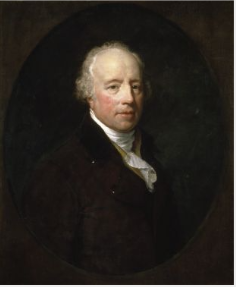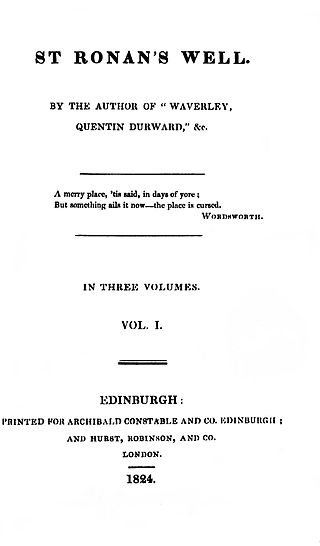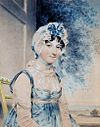
Titus Caesar Vespasianus was Roman emperor from 79 to 81. A member of the Flavian dynasty, Titus succeeded his father Vespasian upon his death.

Maria Edgeworth was a prolific Anglo-Irish novelist of adults' and children's literature. She was one of the first realist writers in children's literature and was a significant figure in the evolution of the novel in Europe. She held critical views on estate management, politics and education, and corresponded with some of the leading literary and economic writers, including Sir Walter Scott and David Ricardo. During the first decade of the 19th century she was one of the most widely read novelists in the British Isles. Her name today most commonly associated with Castle Rackrent, her first novel in which she adopted an Irish Catholic voice to narrate the dissipation and decline of a family from her own landed Anglo-Irish class.
Berenice of Cilicia, also known as Julia Berenice and sometimes spelled Bernice, was a Jewish client queen of the Roman Empire during the second half of the 1st century. Berenice was a member of the Herodian Dynasty that ruled the Roman province of Judaea between 39 BCE and 92 CE. She was the daughter of King Herod Agrippa I and Cypros and a sister of King Herod Agrippa II.

Amelia Opie was an English author who published numerous novels in the Romantic period up to 1828. Opie was also a leading abolitionist in Norwich, England. Hers was the first of 187,000 names presented to the British Parliament on a petition from women to stop slavery.

Daniel Deronda is a novel written by English author George Eliot, first published in eight parts (books) February to September 1876. It was the last novel she completed and the only one set in the Victorian society of her day. The work's mixture of social satire and moral searching, along with its sympathetic rendering of Jewish proto-Zionist ideas, has made it the controversial final statement of one of the most renowned Victorian novelists.
Douglas Lancelot Reed was a British journalist, playwright, novelist and writer of books with political themes. His book Insanity Fair (1938) examined the state of Europe and the megalomania of Adolf Hitler before the Second World War. By the time of his death, Reed had been largely forgotten except for various remarks about Jews. Thus, when The Times ran his obituary, it condemned Reed as a "virulent anti-Semite," although Reed himself claimed that he drew a distinction between opposition to Zionism and antisemitism. Reed believed in a long-term Zionist conspiracy to impose a world government on an enslaved humanity. He was also staunchly anti-Communist, and once wrote that Nazism was a "stooge or stalking horse" meant to further the aims of the "Communist Empire."

Richard Lovell Edgeworth was an Anglo-Irish politician, writer and inventor.

North and South is a social novel published in 1854–55 by English writer Elizabeth Gaskell. With Wives and Daughters (1865) and Cranford (1853), it is one of her best-known novels and was adapted for television three times. Initially, Gaskell wanted the novel to be titled after the heroine, Margaret Hale, but Charles Dickens, the editor of Household Words, the magazine in which the novel was serialised, insisted on North and South.

Saint Ronan's Well is one of the Waverley novels by Sir Walter Scott. Set in a fashionable spa in the Scottish Borders, it is the only novel he wrote with a 19th-century setting.

Fagin is a fictional character and the secondary antagonist in Charles Dickens's 1838 novel Oliver Twist. In the preface to the novel, he is described as a "receiver of stolen goods". He is the leader of a group of children whom he teaches to make their livings by pickpocketing and other criminal activities, in exchange for shelter. A distinguishing trait is his constant and insincere use of the phrase "my dear" when addressing others. At the time of the novel, he is said by another character, Monks, to have already made criminals out of "scores" of children. Nancy, who is the lover of Bill Sikes, is confirmed to be Fagin's former pupil.

The Counterlife (1986) is a novel by the American author Philip Roth. It is the fourth full-length novel to feature the fictional novelist Nathan Zuckerman. When The Counterlife was published, Zuckerman had most recently appeared in a novella called The Prague Orgy, the epilogue to the omnibus volume Zuckerman Bound.
Belinda is an 1801 novel by the Anglo-Irish writer Maria Edgeworth. It was first published in three volumes by Joseph Johnson of London. The novel was Edgeworth's second published, and was considered controversial in its day for its depiction of an interracial marriage. It was reprinted by Pandora Press in 1986.

Emmeline, The Orphan of the Castle is the first novel written by English writer Charlotte Smith; it was published in 1788. A Cinderella story in which the heroine stands outside the traditional economic structures of English society and ends up wealthy and happy, the novel is a fantasy. At the same time, it criticises the traditional marriage arrangements of the 18th century, which allowed women little choice and prioritised the needs of the family. Smith's criticisms of marriage stemmed from her personal experience and several of the secondary characters are thinly veiled depictions of her family, a technique which both intrigued and repelled contemporary readers.
Antigone was a Greek Macedonian noblewoman. Through her mother's second marriage she was a member of the Ptolemaic dynasty and through her marriage to Pyrrhus she was queen of Epirus.
The term useful Jew was used in various historical contexts, typically describing a Jew useful in implementing an official authority's policy, sometimes by oppressing other Jews.

Honora Edgeworth was an eighteenth-century English writer, mainly known for her associations with literary figures of the day particularly Anna Seward and the Lunar Society, and for her work on children's education. Sneyd was born in Bath in 1751, and following the death of her mother in 1756 was raised by Canon Thomas Seward and his wife Elizabeth in Lichfield, Staffordshire until she returned to her father's house in 1771. There, she formed a close friendship with their daughter, Anna Seward. Having had a romantic engagement to John André and having declined the hand of Thomas Day, she married Richard Edgeworth as his second wife in 1773, living on the family estate in Ireland till 1776. There she helped raise his children from his first marriage, including Maria Edgeworth, and two children of her own. Returning to England she fell ill with tuberculosis, which was incurable, dying at Weston in Staffordshire in 1780. She is the subject of a number of Anna Seward's poems, and with her husband developed concepts of childhood education, resulting in a series of books, such as Practical Education, based on her observations of the Edgeworth children. She is known for her stand on women's rights through her vigorous rejection of the proposal by Day, in which she outlined her views on equality in marriage.
Frances Anne Edgeworth (1769–1865), known as Fanny, was an Irish botanical artist and memoirist. She was the stepmother and confidant of the author Maria Edgeworth.
Rachel Mordecai Lazarus was an American educator and correspondent with the children's writer Maria Edgeworth.
Mendoza the Jew: Boxing, Manliness, and Nationalism, A Graphic History is a historical graphic novel written by Ronald Schechter and illustrated by Liz Clarke, and published on November 19, 2013. The comic book features the story of the real life classical pugilist named Daniel Mendoza; a Jewish man who became the heavyweight champion in England and later transformed the sport of boxing.

Mothers of the Novel: 100 Good Women Writers Before Jane Austen (1986), by Dale Spender, is a foundational study for the reclamation project central to feminist literary studies in English in the late 1980s and 1990s.












